Tax Deductions for Business Expenses: A Case Study of Lean and Tasty Pty Ltd
VerifiedAdded on 2022/11/11
|9
|2569
|498
AI Summary
This article discusses tax deductions for business expenses through a case study of Lean and Tasty Pty Ltd. It covers the laws and rules related to deductions for business financing costs, capital allowances, and repairs. The article explains how a business can claim a tax deduction for expenses made for operations and how deductions can be claimed for all costs related to setting up a business. It also discusses the eligibility of small businesses for deductions and concessions. The article concludes by stating that capital expenses cannot be claimed for deductions.
Contribute Materials
Your contribution can guide someone’s learning journey. Share your
documents today.
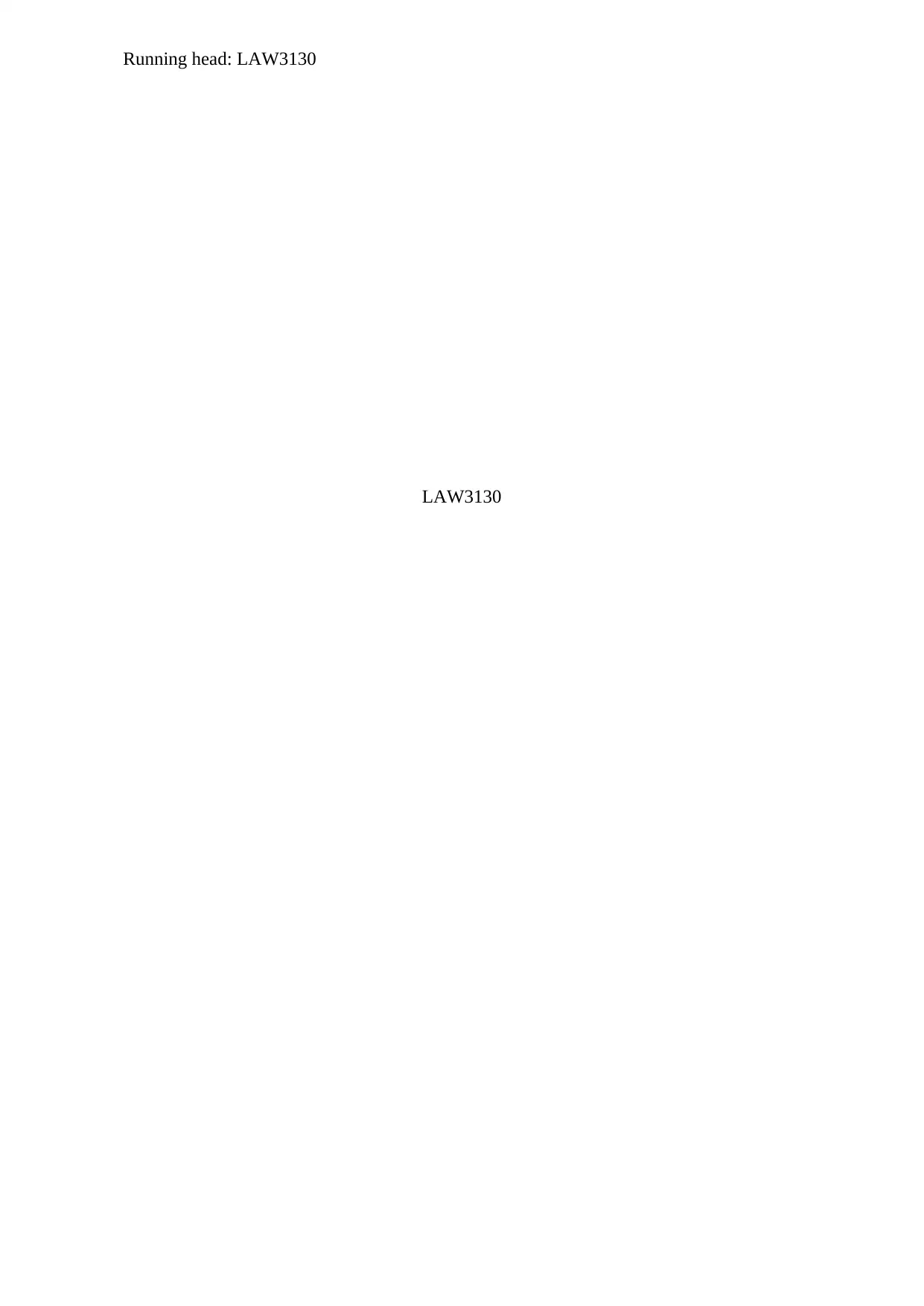
Running head: LAW3130
LAW3130
LAW3130
Secure Best Marks with AI Grader
Need help grading? Try our AI Grader for instant feedback on your assignments.
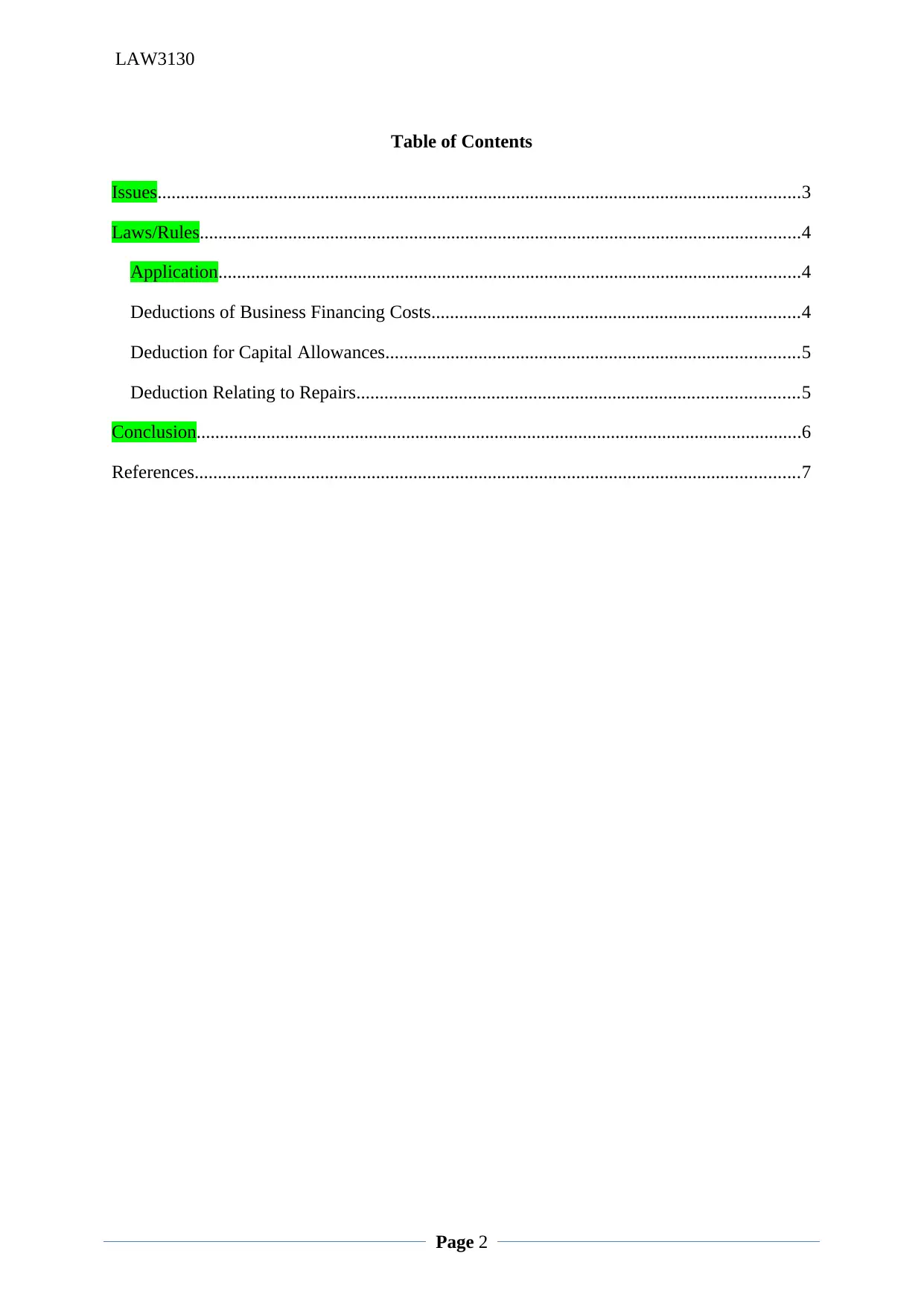
LAW3130
Table of Contents
Issues..........................................................................................................................................3
Laws/Rules.................................................................................................................................4
Application.............................................................................................................................4
Deductions of Business Financing Costs...............................................................................4
Deduction for Capital Allowances.........................................................................................5
Deduction Relating to Repairs...............................................................................................5
Conclusion..................................................................................................................................6
References..................................................................................................................................7
Page 2
Table of Contents
Issues..........................................................................................................................................3
Laws/Rules.................................................................................................................................4
Application.............................................................................................................................4
Deductions of Business Financing Costs...............................................................................4
Deduction for Capital Allowances.........................................................................................5
Deduction Relating to Repairs...............................................................................................5
Conclusion..................................................................................................................................6
References..................................................................................................................................7
Page 2
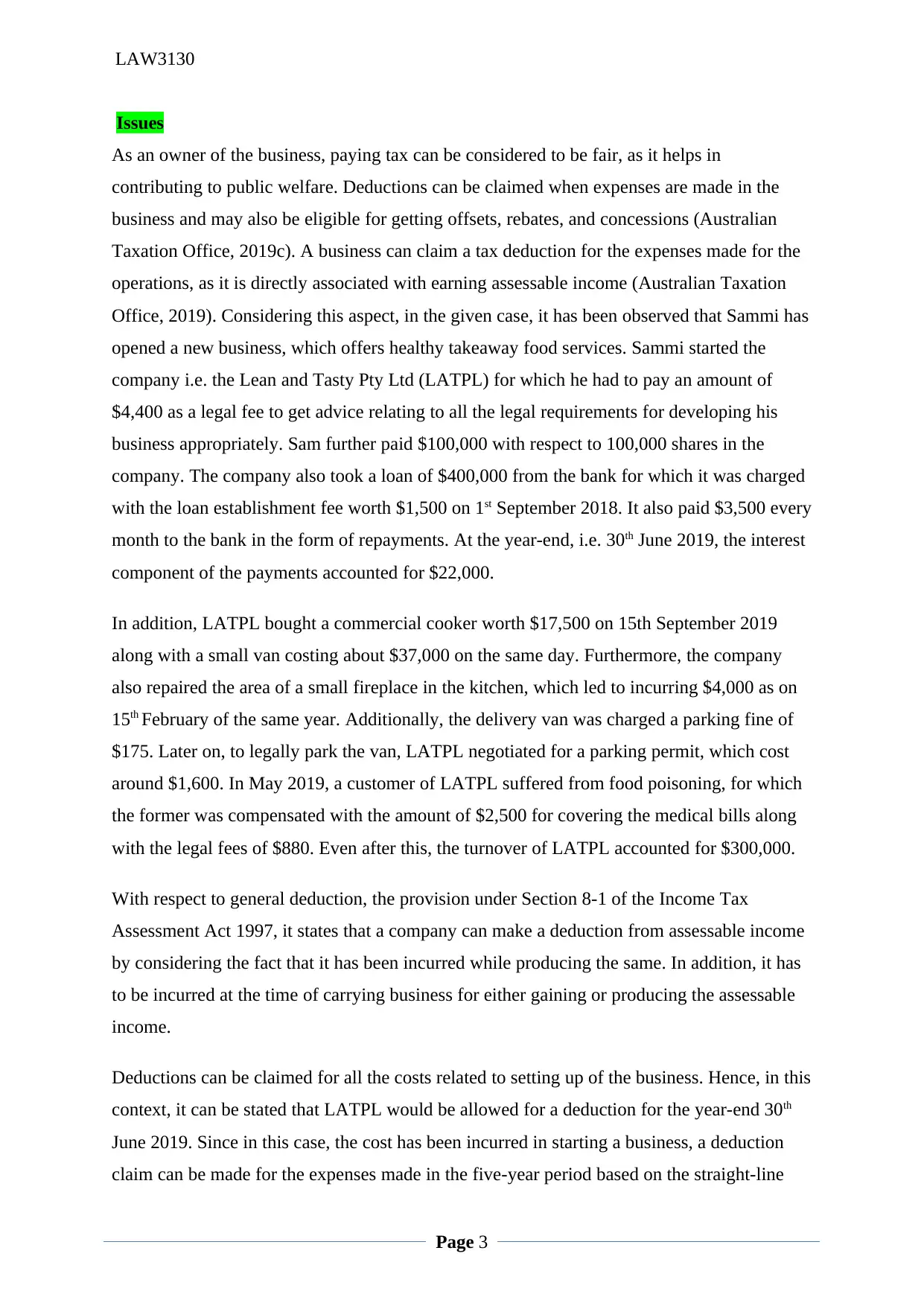
LAW3130
Issues
As an owner of the business, paying tax can be considered to be fair, as it helps in
contributing to public welfare. Deductions can be claimed when expenses are made in the
business and may also be eligible for getting offsets, rebates, and concessions (Australian
Taxation Office, 2019c). A business can claim a tax deduction for the expenses made for the
operations, as it is directly associated with earning assessable income (Australian Taxation
Office, 2019). Considering this aspect, in the given case, it has been observed that Sammi has
opened a new business, which offers healthy takeaway food services. Sammi started the
company i.e. the Lean and Tasty Pty Ltd (LATPL) for which he had to pay an amount of
$4,400 as a legal fee to get advice relating to all the legal requirements for developing his
business appropriately. Sam further paid $100,000 with respect to 100,000 shares in the
company. The company also took a loan of $400,000 from the bank for which it was charged
with the loan establishment fee worth $1,500 on 1st September 2018. It also paid $3,500 every
month to the bank in the form of repayments. At the year-end, i.e. 30th June 2019, the interest
component of the payments accounted for $22,000.
In addition, LATPL bought a commercial cooker worth $17,500 on 15th September 2019
along with a small van costing about $37,000 on the same day. Furthermore, the company
also repaired the area of a small fireplace in the kitchen, which led to incurring $4,000 as on
15th February of the same year. Additionally, the delivery van was charged a parking fine of
$175. Later on, to legally park the van, LATPL negotiated for a parking permit, which cost
around $1,600. In May 2019, a customer of LATPL suffered from food poisoning, for which
the former was compensated with the amount of $2,500 for covering the medical bills along
with the legal fees of $880. Even after this, the turnover of LATPL accounted for $300,000.
With respect to general deduction, the provision under Section 8-1 of the Income Tax
Assessment Act 1997, it states that a company can make a deduction from assessable income
by considering the fact that it has been incurred while producing the same. In addition, it has
to be incurred at the time of carrying business for either gaining or producing the assessable
income.
Deductions can be claimed for all the costs related to setting up of the business. Hence, in this
context, it can be stated that LATPL would be allowed for a deduction for the year-end 30th
June 2019. Since in this case, the cost has been incurred in starting a business, a deduction
claim can be made for the expenses made in the five-year period based on the straight-line
Page 3
Issues
As an owner of the business, paying tax can be considered to be fair, as it helps in
contributing to public welfare. Deductions can be claimed when expenses are made in the
business and may also be eligible for getting offsets, rebates, and concessions (Australian
Taxation Office, 2019c). A business can claim a tax deduction for the expenses made for the
operations, as it is directly associated with earning assessable income (Australian Taxation
Office, 2019). Considering this aspect, in the given case, it has been observed that Sammi has
opened a new business, which offers healthy takeaway food services. Sammi started the
company i.e. the Lean and Tasty Pty Ltd (LATPL) for which he had to pay an amount of
$4,400 as a legal fee to get advice relating to all the legal requirements for developing his
business appropriately. Sam further paid $100,000 with respect to 100,000 shares in the
company. The company also took a loan of $400,000 from the bank for which it was charged
with the loan establishment fee worth $1,500 on 1st September 2018. It also paid $3,500 every
month to the bank in the form of repayments. At the year-end, i.e. 30th June 2019, the interest
component of the payments accounted for $22,000.
In addition, LATPL bought a commercial cooker worth $17,500 on 15th September 2019
along with a small van costing about $37,000 on the same day. Furthermore, the company
also repaired the area of a small fireplace in the kitchen, which led to incurring $4,000 as on
15th February of the same year. Additionally, the delivery van was charged a parking fine of
$175. Later on, to legally park the van, LATPL negotiated for a parking permit, which cost
around $1,600. In May 2019, a customer of LATPL suffered from food poisoning, for which
the former was compensated with the amount of $2,500 for covering the medical bills along
with the legal fees of $880. Even after this, the turnover of LATPL accounted for $300,000.
With respect to general deduction, the provision under Section 8-1 of the Income Tax
Assessment Act 1997, it states that a company can make a deduction from assessable income
by considering the fact that it has been incurred while producing the same. In addition, it has
to be incurred at the time of carrying business for either gaining or producing the assessable
income.
Deductions can be claimed for all the costs related to setting up of the business. Hence, in this
context, it can be stated that LATPL would be allowed for a deduction for the year-end 30th
June 2019. Since in this case, the cost has been incurred in starting a business, a deduction
claim can be made for the expenses made in the five-year period based on the straight-line
Page 3
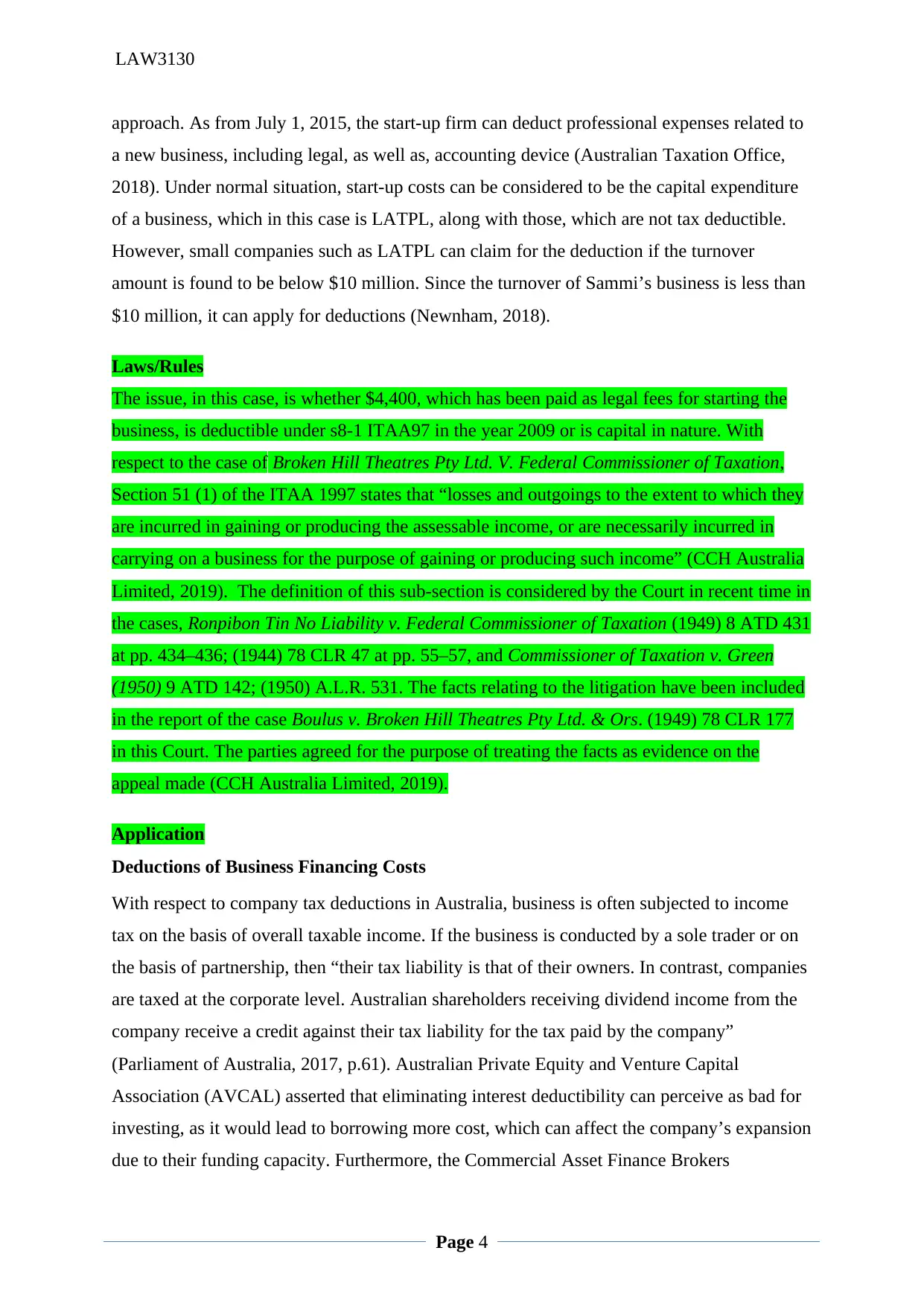
LAW3130
approach. As from July 1, 2015, the start-up firm can deduct professional expenses related to
a new business, including legal, as well as, accounting device (Australian Taxation Office,
2018). Under normal situation, start-up costs can be considered to be the capital expenditure
of a business, which in this case is LATPL, along with those, which are not tax deductible.
However, small companies such as LATPL can claim for the deduction if the turnover
amount is found to be below $10 million. Since the turnover of Sammi’s business is less than
$10 million, it can apply for deductions (Newnham, 2018).
Laws/Rules
The issue, in this case, is whether $4,400, which has been paid as legal fees for starting the
business, is deductible under s8-1 ITAA97 in the year 2009 or is capital in nature. With
respect to the case of Broken Hill Theatres Pty Ltd. V. Federal Commissioner of Taxation,
Section 51 (1) of the ITAA 1997 states that “losses and outgoings to the extent to which they
are incurred in gaining or producing the assessable income, or are necessarily incurred in
carrying on a business for the purpose of gaining or producing such income” (CCH Australia
Limited, 2019). The definition of this sub-section is considered by the Court in recent time in
the cases, Ronpibon Tin No Liability v. Federal Commissioner of Taxation (1949) 8 ATD 431
at pp. 434–436; (1944) 78 CLR 47 at pp. 55–57, and Commissioner of Taxation v. Green
(1950) 9 ATD 142; (1950) A.L.R. 531. The facts relating to the litigation have been included
in the report of the case Boulus v. Broken Hill Theatres Pty Ltd. & Ors. (1949) 78 CLR 177
in this Court. The parties agreed for the purpose of treating the facts as evidence on the
appeal made (CCH Australia Limited, 2019).
Application
Deductions of Business Financing Costs
With respect to company tax deductions in Australia, business is often subjected to income
tax on the basis of overall taxable income. If the business is conducted by a sole trader or on
the basis of partnership, then “their tax liability is that of their owners. In contrast, companies
are taxed at the corporate level. Australian shareholders receiving dividend income from the
company receive a credit against their tax liability for the tax paid by the company”
(Parliament of Australia, 2017, p.61). Australian Private Equity and Venture Capital
Association (AVCAL) asserted that eliminating interest deductibility can perceive as bad for
investing, as it would lead to borrowing more cost, which can affect the company’s expansion
due to their funding capacity. Furthermore, the Commercial Asset Finance Brokers
Page 4
approach. As from July 1, 2015, the start-up firm can deduct professional expenses related to
a new business, including legal, as well as, accounting device (Australian Taxation Office,
2018). Under normal situation, start-up costs can be considered to be the capital expenditure
of a business, which in this case is LATPL, along with those, which are not tax deductible.
However, small companies such as LATPL can claim for the deduction if the turnover
amount is found to be below $10 million. Since the turnover of Sammi’s business is less than
$10 million, it can apply for deductions (Newnham, 2018).
Laws/Rules
The issue, in this case, is whether $4,400, which has been paid as legal fees for starting the
business, is deductible under s8-1 ITAA97 in the year 2009 or is capital in nature. With
respect to the case of Broken Hill Theatres Pty Ltd. V. Federal Commissioner of Taxation,
Section 51 (1) of the ITAA 1997 states that “losses and outgoings to the extent to which they
are incurred in gaining or producing the assessable income, or are necessarily incurred in
carrying on a business for the purpose of gaining or producing such income” (CCH Australia
Limited, 2019). The definition of this sub-section is considered by the Court in recent time in
the cases, Ronpibon Tin No Liability v. Federal Commissioner of Taxation (1949) 8 ATD 431
at pp. 434–436; (1944) 78 CLR 47 at pp. 55–57, and Commissioner of Taxation v. Green
(1950) 9 ATD 142; (1950) A.L.R. 531. The facts relating to the litigation have been included
in the report of the case Boulus v. Broken Hill Theatres Pty Ltd. & Ors. (1949) 78 CLR 177
in this Court. The parties agreed for the purpose of treating the facts as evidence on the
appeal made (CCH Australia Limited, 2019).
Application
Deductions of Business Financing Costs
With respect to company tax deductions in Australia, business is often subjected to income
tax on the basis of overall taxable income. If the business is conducted by a sole trader or on
the basis of partnership, then “their tax liability is that of their owners. In contrast, companies
are taxed at the corporate level. Australian shareholders receiving dividend income from the
company receive a credit against their tax liability for the tax paid by the company”
(Parliament of Australia, 2017, p.61). Australian Private Equity and Venture Capital
Association (AVCAL) asserted that eliminating interest deductibility can perceive as bad for
investing, as it would lead to borrowing more cost, which can affect the company’s expansion
due to their funding capacity. Furthermore, the Commercial Asset Finance Brokers
Page 4
Secure Best Marks with AI Grader
Need help grading? Try our AI Grader for instant feedback on your assignments.
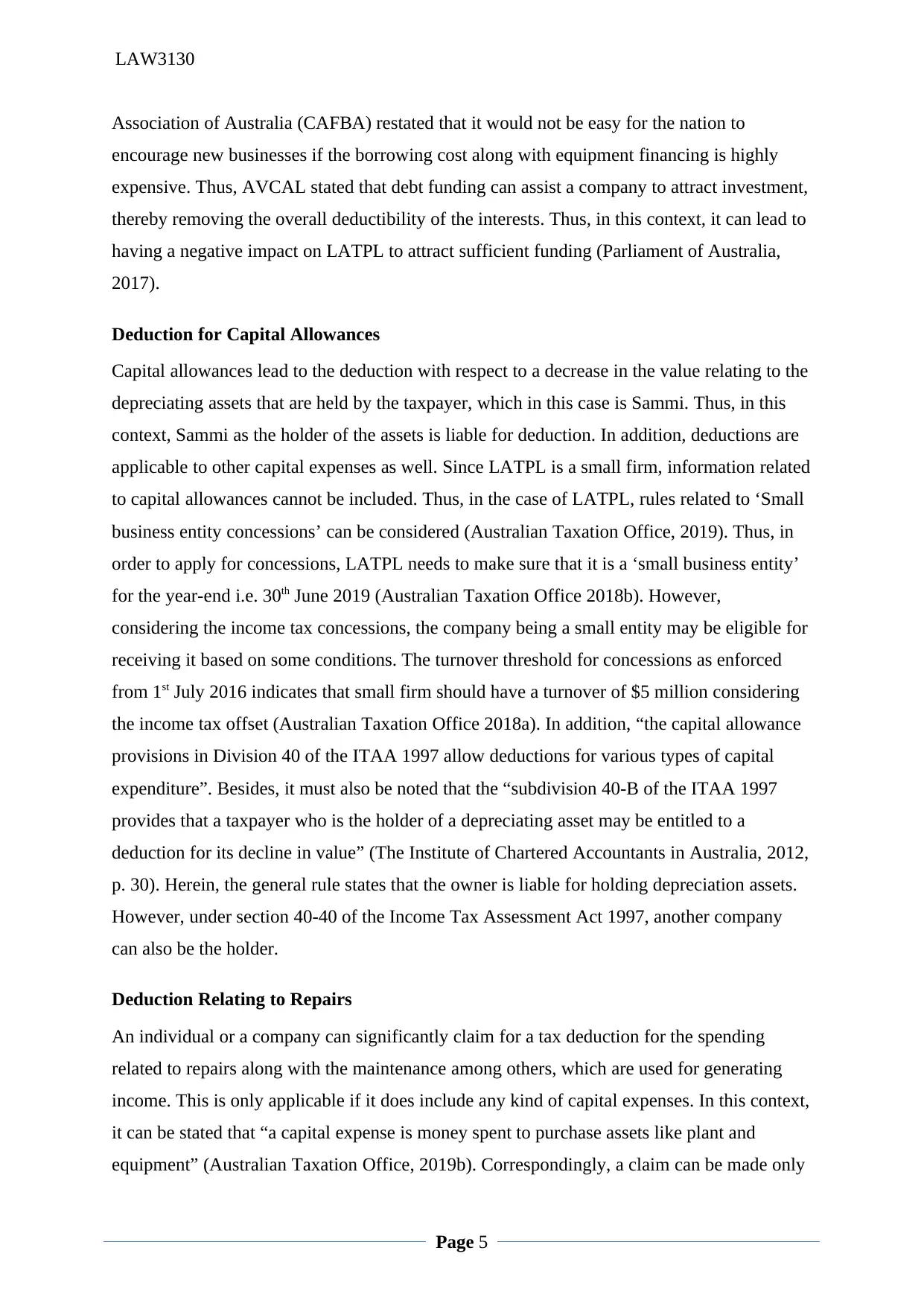
LAW3130
Association of Australia (CAFBA) restated that it would not be easy for the nation to
encourage new businesses if the borrowing cost along with equipment financing is highly
expensive. Thus, AVCAL stated that debt funding can assist a company to attract investment,
thereby removing the overall deductibility of the interests. Thus, in this context, it can lead to
having a negative impact on LATPL to attract sufficient funding (Parliament of Australia,
2017).
Deduction for Capital Allowances
Capital allowances lead to the deduction with respect to a decrease in the value relating to the
depreciating assets that are held by the taxpayer, which in this case is Sammi. Thus, in this
context, Sammi as the holder of the assets is liable for deduction. In addition, deductions are
applicable to other capital expenses as well. Since LATPL is a small firm, information related
to capital allowances cannot be included. Thus, in the case of LATPL, rules related to ‘Small
business entity concessions’ can be considered (Australian Taxation Office, 2019). Thus, in
order to apply for concessions, LATPL needs to make sure that it is a ‘small business entity’
for the year-end i.e. 30th June 2019 (Australian Taxation Office 2018b). However,
considering the income tax concessions, the company being a small entity may be eligible for
receiving it based on some conditions. The turnover threshold for concessions as enforced
from 1st July 2016 indicates that small firm should have a turnover of $5 million considering
the income tax offset (Australian Taxation Office 2018a). In addition, “the capital allowance
provisions in Division 40 of the ITAA 1997 allow deductions for various types of capital
expenditure”. Besides, it must also be noted that the “subdivision 40-B of the ITAA 1997
provides that a taxpayer who is the holder of a depreciating asset may be entitled to a
deduction for its decline in value” (The Institute of Chartered Accountants in Australia, 2012,
p. 30). Herein, the general rule states that the owner is liable for holding depreciation assets.
However, under section 40-40 of the Income Tax Assessment Act 1997, another company
can also be the holder.
Deduction Relating to Repairs
An individual or a company can significantly claim for a tax deduction for the spending
related to repairs along with the maintenance among others, which are used for generating
income. This is only applicable if it does include any kind of capital expenses. In this context,
it can be stated that “a capital expense is money spent to purchase assets like plant and
equipment” (Australian Taxation Office, 2019b). Correspondingly, a claim can be made only
Page 5
Association of Australia (CAFBA) restated that it would not be easy for the nation to
encourage new businesses if the borrowing cost along with equipment financing is highly
expensive. Thus, AVCAL stated that debt funding can assist a company to attract investment,
thereby removing the overall deductibility of the interests. Thus, in this context, it can lead to
having a negative impact on LATPL to attract sufficient funding (Parliament of Australia,
2017).
Deduction for Capital Allowances
Capital allowances lead to the deduction with respect to a decrease in the value relating to the
depreciating assets that are held by the taxpayer, which in this case is Sammi. Thus, in this
context, Sammi as the holder of the assets is liable for deduction. In addition, deductions are
applicable to other capital expenses as well. Since LATPL is a small firm, information related
to capital allowances cannot be included. Thus, in the case of LATPL, rules related to ‘Small
business entity concessions’ can be considered (Australian Taxation Office, 2019). Thus, in
order to apply for concessions, LATPL needs to make sure that it is a ‘small business entity’
for the year-end i.e. 30th June 2019 (Australian Taxation Office 2018b). However,
considering the income tax concessions, the company being a small entity may be eligible for
receiving it based on some conditions. The turnover threshold for concessions as enforced
from 1st July 2016 indicates that small firm should have a turnover of $5 million considering
the income tax offset (Australian Taxation Office 2018a). In addition, “the capital allowance
provisions in Division 40 of the ITAA 1997 allow deductions for various types of capital
expenditure”. Besides, it must also be noted that the “subdivision 40-B of the ITAA 1997
provides that a taxpayer who is the holder of a depreciating asset may be entitled to a
deduction for its decline in value” (The Institute of Chartered Accountants in Australia, 2012,
p. 30). Herein, the general rule states that the owner is liable for holding depreciation assets.
However, under section 40-40 of the Income Tax Assessment Act 1997, another company
can also be the holder.
Deduction Relating to Repairs
An individual or a company can significantly claim for a tax deduction for the spending
related to repairs along with the maintenance among others, which are used for generating
income. This is only applicable if it does include any kind of capital expenses. In this context,
it can be stated that “a capital expense is money spent to purchase assets like plant and
equipment” (Australian Taxation Office, 2019b). Correspondingly, a claim can be made only
Page 5
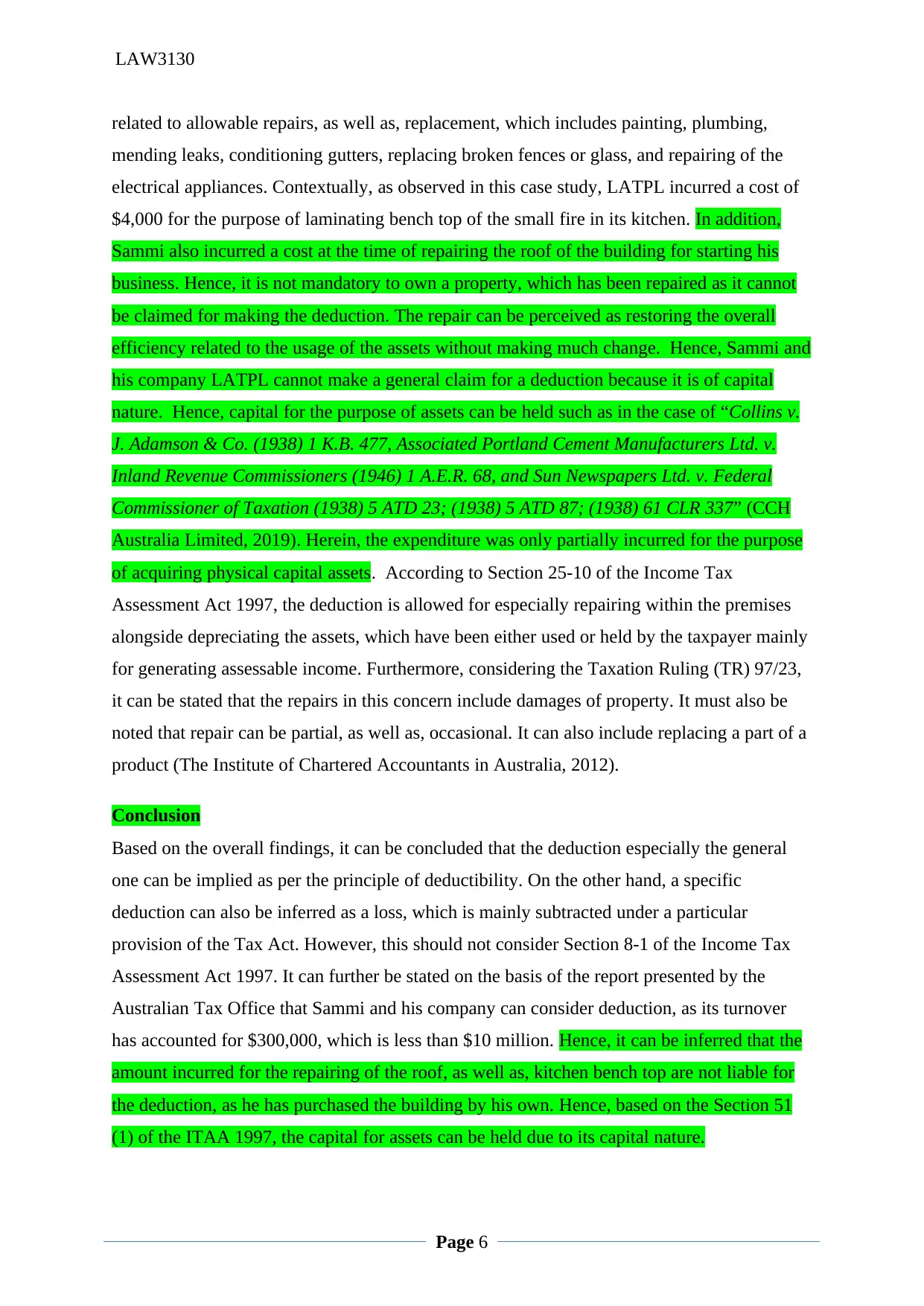
LAW3130
related to allowable repairs, as well as, replacement, which includes painting, plumbing,
mending leaks, conditioning gutters, replacing broken fences or glass, and repairing of the
electrical appliances. Contextually, as observed in this case study, LATPL incurred a cost of
$4,000 for the purpose of laminating bench top of the small fire in its kitchen. In addition,
Sammi also incurred a cost at the time of repairing the roof of the building for starting his
business. Hence, it is not mandatory to own a property, which has been repaired as it cannot
be claimed for making the deduction. The repair can be perceived as restoring the overall
efficiency related to the usage of the assets without making much change. Hence, Sammi and
his company LATPL cannot make a general claim for a deduction because it is of capital
nature. Hence, capital for the purpose of assets can be held such as in the case of “Collins v.
J. Adamson & Co. (1938) 1 K.B. 477, Associated Portland Cement Manufacturers Ltd. v.
Inland Revenue Commissioners (1946) 1 A.E.R. 68, and Sun Newspapers Ltd. v. Federal
Commissioner of Taxation (1938) 5 ATD 23; (1938) 5 ATD 87; (1938) 61 CLR 337” (CCH
Australia Limited, 2019). Herein, the expenditure was only partially incurred for the purpose
of acquiring physical capital assets. According to Section 25-10 of the Income Tax
Assessment Act 1997, the deduction is allowed for especially repairing within the premises
alongside depreciating the assets, which have been either used or held by the taxpayer mainly
for generating assessable income. Furthermore, considering the Taxation Ruling (TR) 97/23,
it can be stated that the repairs in this concern include damages of property. It must also be
noted that repair can be partial, as well as, occasional. It can also include replacing a part of a
product (The Institute of Chartered Accountants in Australia, 2012).
Conclusion
Based on the overall findings, it can be concluded that the deduction especially the general
one can be implied as per the principle of deductibility. On the other hand, a specific
deduction can also be inferred as a loss, which is mainly subtracted under a particular
provision of the Tax Act. However, this should not consider Section 8-1 of the Income Tax
Assessment Act 1997. It can further be stated on the basis of the report presented by the
Australian Tax Office that Sammi and his company can consider deduction, as its turnover
has accounted for $300,000, which is less than $10 million. Hence, it can be inferred that the
amount incurred for the repairing of the roof, as well as, kitchen bench top are not liable for
the deduction, as he has purchased the building by his own. Hence, based on the Section 51
(1) of the ITAA 1997, the capital for assets can be held due to its capital nature.
Page 6
related to allowable repairs, as well as, replacement, which includes painting, plumbing,
mending leaks, conditioning gutters, replacing broken fences or glass, and repairing of the
electrical appliances. Contextually, as observed in this case study, LATPL incurred a cost of
$4,000 for the purpose of laminating bench top of the small fire in its kitchen. In addition,
Sammi also incurred a cost at the time of repairing the roof of the building for starting his
business. Hence, it is not mandatory to own a property, which has been repaired as it cannot
be claimed for making the deduction. The repair can be perceived as restoring the overall
efficiency related to the usage of the assets without making much change. Hence, Sammi and
his company LATPL cannot make a general claim for a deduction because it is of capital
nature. Hence, capital for the purpose of assets can be held such as in the case of “Collins v.
J. Adamson & Co. (1938) 1 K.B. 477, Associated Portland Cement Manufacturers Ltd. v.
Inland Revenue Commissioners (1946) 1 A.E.R. 68, and Sun Newspapers Ltd. v. Federal
Commissioner of Taxation (1938) 5 ATD 23; (1938) 5 ATD 87; (1938) 61 CLR 337” (CCH
Australia Limited, 2019). Herein, the expenditure was only partially incurred for the purpose
of acquiring physical capital assets. According to Section 25-10 of the Income Tax
Assessment Act 1997, the deduction is allowed for especially repairing within the premises
alongside depreciating the assets, which have been either used or held by the taxpayer mainly
for generating assessable income. Furthermore, considering the Taxation Ruling (TR) 97/23,
it can be stated that the repairs in this concern include damages of property. It must also be
noted that repair can be partial, as well as, occasional. It can also include replacing a part of a
product (The Institute of Chartered Accountants in Australia, 2012).
Conclusion
Based on the overall findings, it can be concluded that the deduction especially the general
one can be implied as per the principle of deductibility. On the other hand, a specific
deduction can also be inferred as a loss, which is mainly subtracted under a particular
provision of the Tax Act. However, this should not consider Section 8-1 of the Income Tax
Assessment Act 1997. It can further be stated on the basis of the report presented by the
Australian Tax Office that Sammi and his company can consider deduction, as its turnover
has accounted for $300,000, which is less than $10 million. Hence, it can be inferred that the
amount incurred for the repairing of the roof, as well as, kitchen bench top are not liable for
the deduction, as he has purchased the building by his own. Hence, based on the Section 51
(1) of the ITAA 1997, the capital for assets can be held due to its capital nature.
Page 6
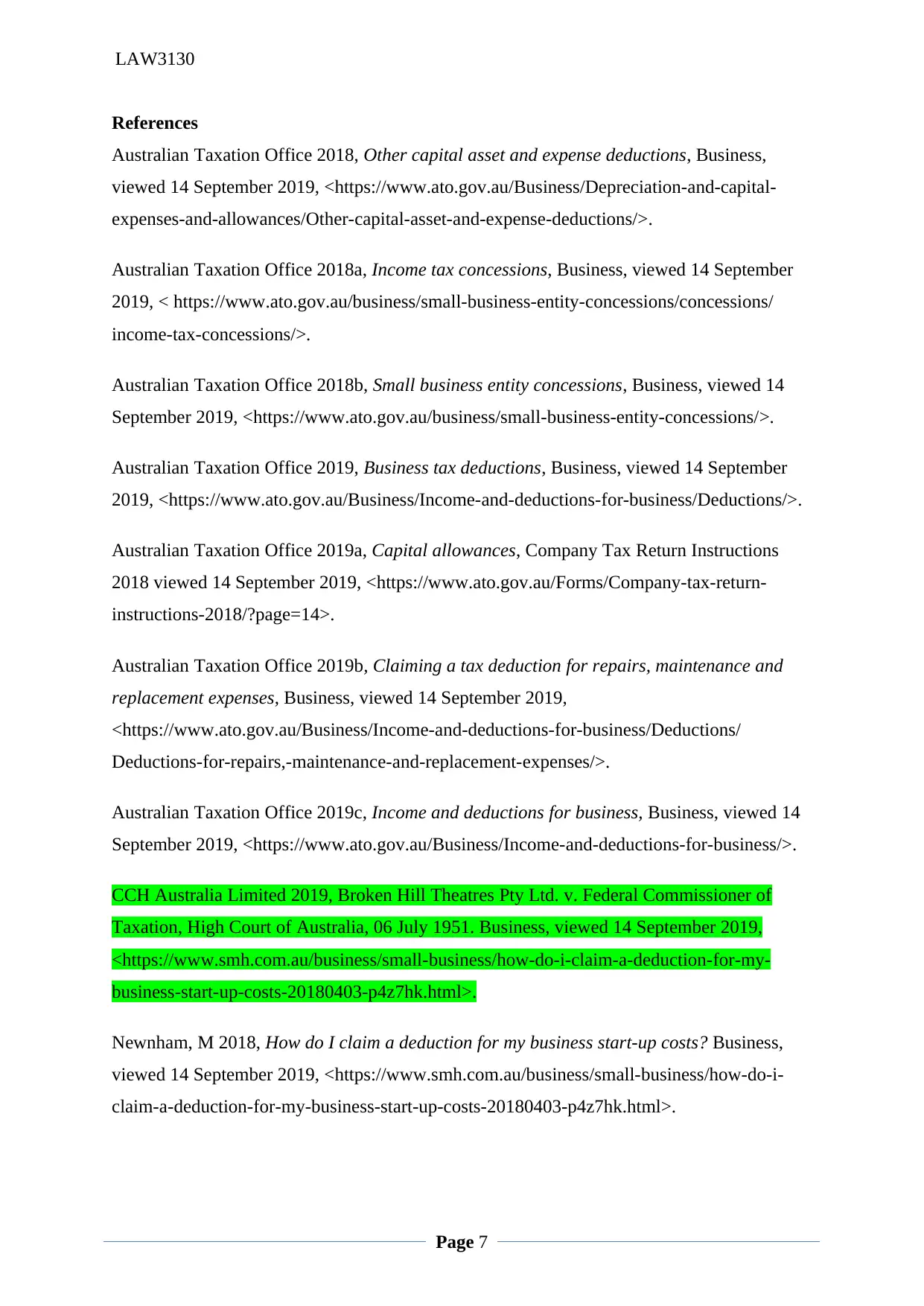
LAW3130
References
Australian Taxation Office 2018, Other capital asset and expense deductions, Business,
viewed 14 September 2019, <https://www.ato.gov.au/Business/Depreciation-and-capital-
expenses-and-allowances/Other-capital-asset-and-expense-deductions/>.
Australian Taxation Office 2018a, Income tax concessions, Business, viewed 14 September
2019, < https://www.ato.gov.au/business/small-business-entity-concessions/concessions/
income-tax-concessions/>.
Australian Taxation Office 2018b, Small business entity concessions, Business, viewed 14
September 2019, <https://www.ato.gov.au/business/small-business-entity-concessions/>.
Australian Taxation Office 2019, Business tax deductions, Business, viewed 14 September
2019, <https://www.ato.gov.au/Business/Income-and-deductions-for-business/Deductions/>.
Australian Taxation Office 2019a, Capital allowances, Company Tax Return Instructions
2018 viewed 14 September 2019, <https://www.ato.gov.au/Forms/Company-tax-return-
instructions-2018/?page=14>.
Australian Taxation Office 2019b, Claiming a tax deduction for repairs, maintenance and
replacement expenses, Business, viewed 14 September 2019,
<https://www.ato.gov.au/Business/Income-and-deductions-for-business/Deductions/
Deductions-for-repairs,-maintenance-and-replacement-expenses/>.
Australian Taxation Office 2019c, Income and deductions for business, Business, viewed 14
September 2019, <https://www.ato.gov.au/Business/Income-and-deductions-for-business/>.
CCH Australia Limited 2019, Broken Hill Theatres Pty Ltd. v. Federal Commissioner of
Taxation, High Court of Australia, 06 July 1951. Business, viewed 14 September 2019,
<https://www.smh.com.au/business/small-business/how-do-i-claim-a-deduction-for-my-
business-start-up-costs-20180403-p4z7hk.html>.
Newnham, M 2018, How do I claim a deduction for my business start-up costs? Business,
viewed 14 September 2019, <https://www.smh.com.au/business/small-business/how-do-i-
claim-a-deduction-for-my-business-start-up-costs-20180403-p4z7hk.html>.
Page 7
References
Australian Taxation Office 2018, Other capital asset and expense deductions, Business,
viewed 14 September 2019, <https://www.ato.gov.au/Business/Depreciation-and-capital-
expenses-and-allowances/Other-capital-asset-and-expense-deductions/>.
Australian Taxation Office 2018a, Income tax concessions, Business, viewed 14 September
2019, < https://www.ato.gov.au/business/small-business-entity-concessions/concessions/
income-tax-concessions/>.
Australian Taxation Office 2018b, Small business entity concessions, Business, viewed 14
September 2019, <https://www.ato.gov.au/business/small-business-entity-concessions/>.
Australian Taxation Office 2019, Business tax deductions, Business, viewed 14 September
2019, <https://www.ato.gov.au/Business/Income-and-deductions-for-business/Deductions/>.
Australian Taxation Office 2019a, Capital allowances, Company Tax Return Instructions
2018 viewed 14 September 2019, <https://www.ato.gov.au/Forms/Company-tax-return-
instructions-2018/?page=14>.
Australian Taxation Office 2019b, Claiming a tax deduction for repairs, maintenance and
replacement expenses, Business, viewed 14 September 2019,
<https://www.ato.gov.au/Business/Income-and-deductions-for-business/Deductions/
Deductions-for-repairs,-maintenance-and-replacement-expenses/>.
Australian Taxation Office 2019c, Income and deductions for business, Business, viewed 14
September 2019, <https://www.ato.gov.au/Business/Income-and-deductions-for-business/>.
CCH Australia Limited 2019, Broken Hill Theatres Pty Ltd. v. Federal Commissioner of
Taxation, High Court of Australia, 06 July 1951. Business, viewed 14 September 2019,
<https://www.smh.com.au/business/small-business/how-do-i-claim-a-deduction-for-my-
business-start-up-costs-20180403-p4z7hk.html>.
Newnham, M 2018, How do I claim a deduction for my business start-up costs? Business,
viewed 14 September 2019, <https://www.smh.com.au/business/small-business/how-do-i-
claim-a-deduction-for-my-business-start-up-costs-20180403-p4z7hk.html>.
Page 7
Paraphrase This Document
Need a fresh take? Get an instant paraphrase of this document with our AI Paraphraser
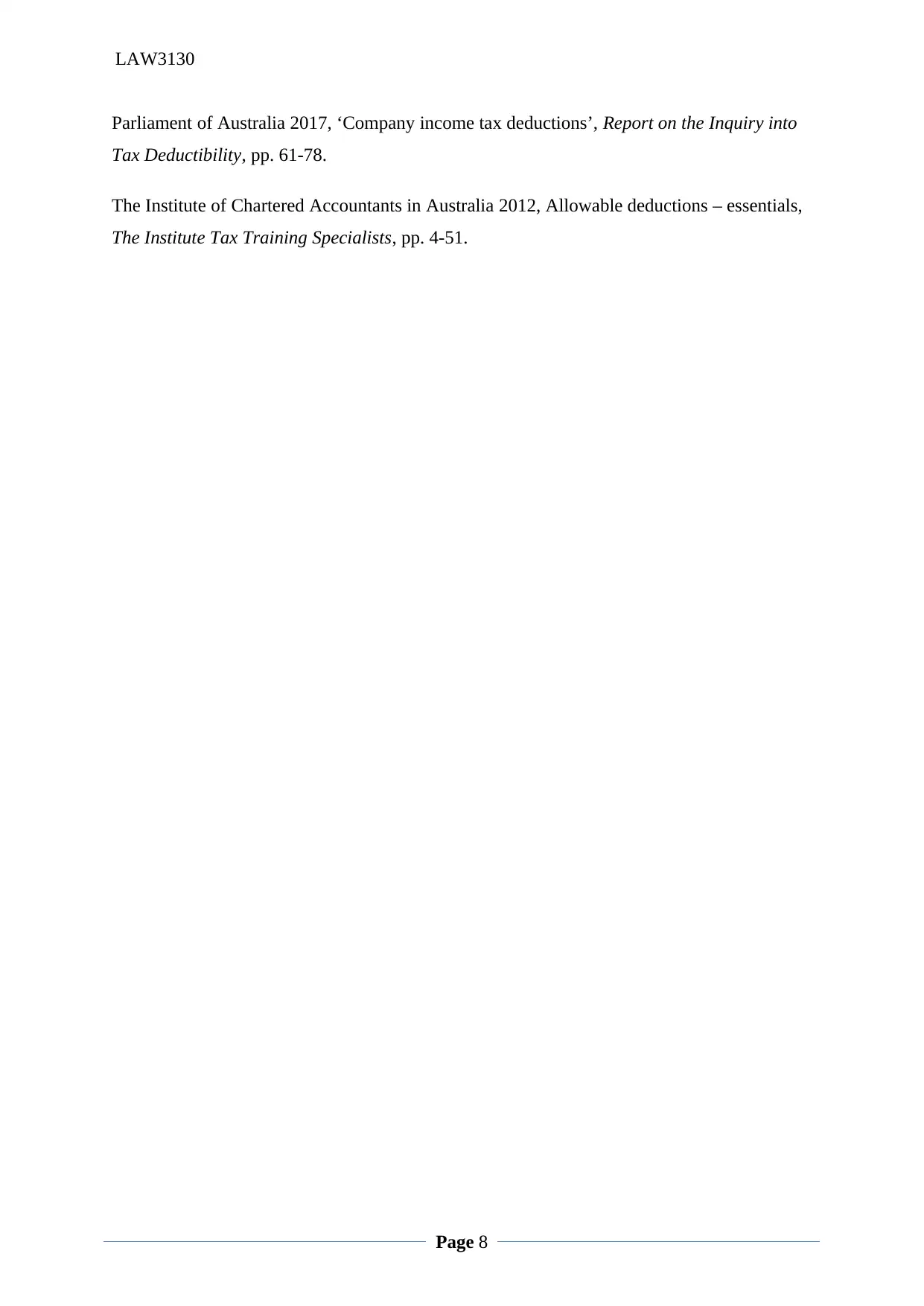
LAW3130
Parliament of Australia 2017, ‘Company income tax deductions’, Report on the Inquiry into
Tax Deductibility, pp. 61-78.
The Institute of Chartered Accountants in Australia 2012, Allowable deductions – essentials,
The Institute Tax Training Specialists, pp. 4-51.
Page 8
Parliament of Australia 2017, ‘Company income tax deductions’, Report on the Inquiry into
Tax Deductibility, pp. 61-78.
The Institute of Chartered Accountants in Australia 2012, Allowable deductions – essentials,
The Institute Tax Training Specialists, pp. 4-51.
Page 8
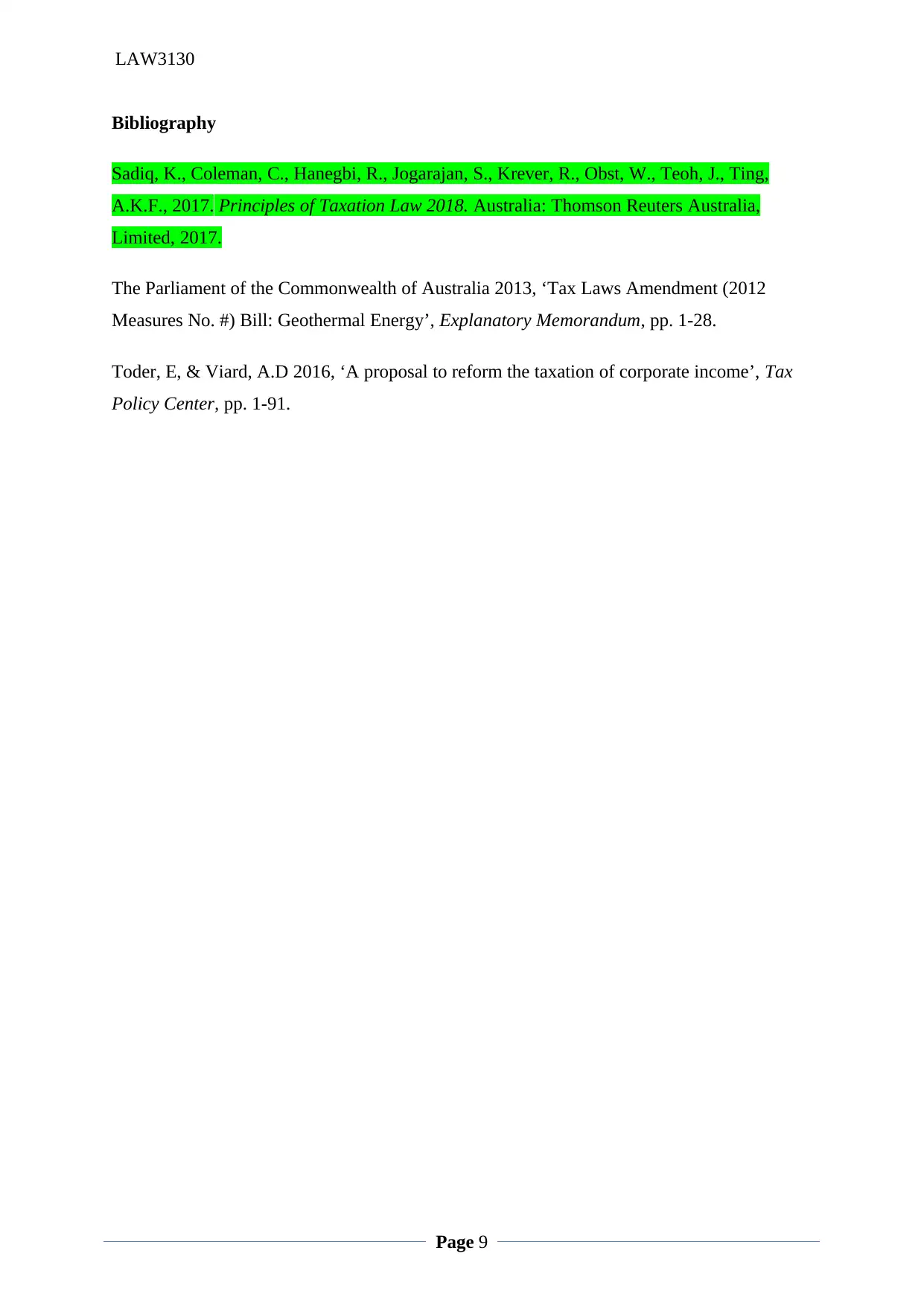
LAW3130
Bibliography
Sadiq, K., Coleman, C., Hanegbi, R., Jogarajan, S., Krever, R., Obst, W., Teoh, J., Ting,
A.K.F., 2017. Principles of Taxation Law 2018. Australia: Thomson Reuters Australia,
Limited, 2017.
The Parliament of the Commonwealth of Australia 2013, ‘Tax Laws Amendment (2012
Measures No. #) Bill: Geothermal Energy’, Explanatory Memorandum, pp. 1-28.
Toder, E, & Viard, A.D 2016, ‘A proposal to reform the taxation of corporate income’, Tax
Policy Center, pp. 1-91.
Page 9
Bibliography
Sadiq, K., Coleman, C., Hanegbi, R., Jogarajan, S., Krever, R., Obst, W., Teoh, J., Ting,
A.K.F., 2017. Principles of Taxation Law 2018. Australia: Thomson Reuters Australia,
Limited, 2017.
The Parliament of the Commonwealth of Australia 2013, ‘Tax Laws Amendment (2012
Measures No. #) Bill: Geothermal Energy’, Explanatory Memorandum, pp. 1-28.
Toder, E, & Viard, A.D 2016, ‘A proposal to reform the taxation of corporate income’, Tax
Policy Center, pp. 1-91.
Page 9
1 out of 9
Related Documents
Your All-in-One AI-Powered Toolkit for Academic Success.
+13062052269
info@desklib.com
Available 24*7 on WhatsApp / Email
![[object Object]](/_next/static/media/star-bottom.7253800d.svg)
Unlock your academic potential
© 2024 | Zucol Services PVT LTD | All rights reserved.




